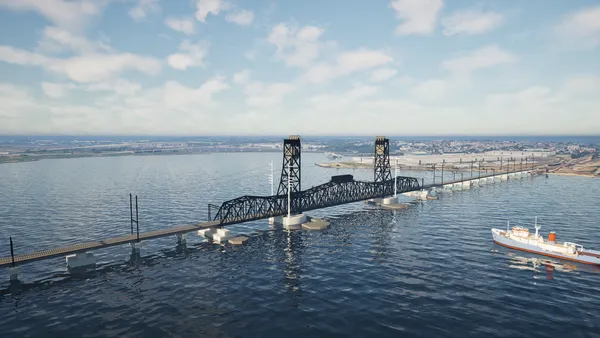About 10 years ago, engineers at the University of Maine’s Advanced Structures and Composites Center developed Bridge-in-a-Backpack, an arch bridge system with components that can be hauled in a bag and quickly assembled to form a span that can reportedly last up to 100 years. But arch bridges represent only a small percentage of the aging bridges that need to be replaced in the U.S., according to Habib Dagher, executive director of the center.
So taking up a similar line of thinking, he and his team developed a composite girder bridge system — a more common type of bridge structure — that they say is easily transportable and more than twice as collapse-resistant as typical concrete or steel girder bridges.
Typically, an engineer who’s asked to design a girder bridge looks for the most lightweight and least expensive option, Dagher told Construction Dive. “We wanted that as well, but we also wanted to make it easier to transport, assemble, erect and then retrofit in the future,” he said. “Our design philosophy has been to look at the entire lifecycle.”
The system is comprised of lightweight, composite girders that connect to precast concrete panels. Contractors can drop a deck segment on top of the girders and connection system and grout them within a few hours, according to Dagher. While the team did not disclose the type of materials used in its proprietary composite blend, Dagher said they are being used simultaneously in a way "they have never been used before."
While the girder is designed to last 100 years, a bridge deck typically lasts 40 to 50 years in Maine’s environment, he said. “The unique connection system we’ve developed allows you to come in 50 years later, essentially pull the deck out and then put the new deck on without having to jackhammer the concrete deck like you typically would.”
The design reduces construction costs, road congestion and maintenance needs, he said, while helping contractors wrap up projects before winter sets in.
Girder bridge system wins praise
The University of Maine researchers’ long-term thinking and goal of extending the lives of bridges has won them the support of the Maine Department of Transportation, Army Corps of Engineers and state politicians. The engineers said that their composite girder bridge system can be built in 72 hours and is ready for market in highway, pedestrian or military applications.
The University of Maine's girder bridge system was not only designed for structural performance and fast assembly, but also for efficient transportation, Dagher said, with a stackable and nesting shape. Because one girder can lay inside another, materials for three to four bridges can be transported on a single flatbed truck, according to the university team. And once these materials arrive at the site, Dagher said they can be offloaded and put in place more lightweight equipment than steel or concrete bridge assembly requires.
Earlier this month, the researchers used computer-controlled hydraulic equipment to simulate heavy truck loads on a 21-foot bridge span, according to a University of Maine announcement, and found that the system can withstand more than five times the load specified by the American Association of State Highway and Transportation Officials. The team saw no damage in the bridge and next month will take the bridge to failure, Dagher said, in order to confirm collapse rate before taking it to market.
Advanced Infrastructure Technologies, the same company that licensed the university's Bridge-in-a-Backpack, will license the composite girder system, Dagher said, with the goal of starting construction on demonstration projects next year.













